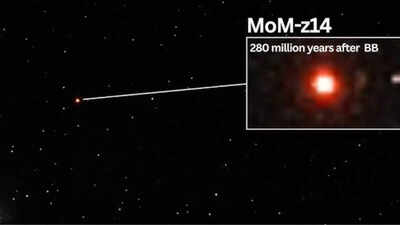
The
James Webb Space Telescope
(JWST) has once again made history by discovering the most distant and ancient galaxy ever observed, named MoM z14. Located just 280 million years after the Big Bang, this galaxy pushes the boundaries of cosmic observation. The finding highlights JWST’s exceptional ability to peer into the early universe, offering unprecedented insights into the formation of the first galaxies. With its record-breaking redshift of z = 14.44, MoM z14 not only redefines our understanding of galaxy evolution but also suggests that even earlier galaxies may soon be within reach, marking a new era in astronomy.
JWST discovers one of the earliest galaxies formed after the Big Bang
NASA's $10 billion space telescope has spotted a galaxy that was present only 280 million years after the Big Bang, a time that astronomers refer to as "cosmic dawn." The discovery team dubbed this galaxy MoM z14—"Mother of all early galaxies" for short."First and foremost, at the moment, this is the most distant object known to humanity," said Pieter van Dokkum, Yale University professor of Astronomy and Physics, in an interview. “MoM z14 existed when the universe was about 280 million years old—we’re getting quite close to the Big Bang. Just to put that in context, sharks have been around on Earth for a longer timespan!”
Since entering service in mid-2022, the JWST has been outstanding at detecting very distant galaxies by means of an effect known as redshift. When the universe gets bigger, light from old galaxies gets stretched, moving toward the red end of the spectrum. The more distant and thus older the galaxy is, the higher the redshift. Prior to MoM z14, the then-record holder was a galaxy named JADES-GS-z14-0, seen at a redshift of z = 14.32, some 300 million years following the Big Bang. MoM z14 is all the more impressive with a redshift of z = 14.44, extending modern astronomy's observational limits.
Discovery of MoM z14 reshapes the view of galaxy formation
In van Dokkum's view, the discovery of MoM z14 is not merely a new record—it provokes earlier hypotheses on the early formation of galaxies. "The bigger picture here is that JWST wasn't supposed to discover any galaxies this early in the universe's history at least, or at least at this point in the mission," he states.Previous JWST models predicted significantly fewer bright galaxies in the universe's early days. Current observations indicate more than 100 such galaxies exist in the early universe—significantly more than before.
What sets MoM z14 apart
Aside from its record-setting age, scientists were able to glean useful insight into MoM z14's composition and structure:
- Size: Roughly 50 times smaller than the Milky Way.
- Star formation: The galaxy possesses unexplained emission lines showing that it is extremely young and quickly producing new stars.
- Chemical composition: Existence of carbon and nitrogen, which implies that it's not one of the absolute first generation galaxies.
"These things suggest that there had to be previous galaxies made only of hydrogen and helium that existed prior to MoM z14," said van Dokkum. "MoM z14 might be the first generation of 'normal' galaxies that started making heavier elements using processes in stars."Also Read | Meteorite that hit Earth 3.26 billion years ago may have sparked good news for life, study reveals

 1 day ago
49
1 day ago
49




























 English (US)
English (US)